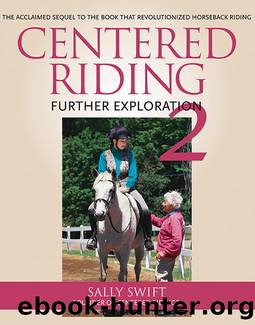Centered Riding 2 by Sally Swift

Author:Sally Swift
Language: eng
Format: epub
Publisher: Trafalgar Square Books
12.1 A & B Cynthia is âfindingâ her hip joints with her hands. It would be more precise if she had pointed to them with her fingertips the same way that Beth does in figure 5.9 (A). Cynthia is locating her greater trochanters (B).
When your knees flex, they should point a little outward rather than straight ahead. Your lower back must be free enough to allow the pelvis to move a bit as the knees bend. Think of your trampoline as your horseâs back. As you alternately flex each leg, one side of his back comes up a little, and then goes down. If you have no trampoline, simply imagine the trampolineâs motion.
Keep transferring your weight from one foot to the other with these small joint flexions. Note as you work that all the joints of your legâhip, knee, and ankleâbecome increasingly soft and mobile. You will also notice how much of the lift comes from the trampoline if you keep receiving its upward push and allow it to travel up through your body and out your head. As you continue to receive this motion, you will find your body and the top of your head moving softly up and down. Take a few moments to discover when the rhythm of your bounces is such that the thrust up feels equal to the drop down. With the wrong rhythm, the downbeat will feel heavier. It is common to work in too rapid a tempo at first. As you slow the rhythm, the up thrust of the trampoline will begin to feel stronger until the up and down become equal. This equalizing of the beats through finding the correct rhythm will also be true on your horse. Keeping your joints soft, especially the hips, and allowing yourself to receive the upward thrust are the keys to finding this rhythm.
To emphasize this point, try stiffening your hips as you continue to step downward with your alternating feet. Two things become immediately apparent. First, it feels awkward and uncomfortable. You canât help but think, âOh, the poor horse!â Second, you will notice that there is little or no up-and-down motion of your body. You are not able to receive the upward beat and the top of your head stays in the same place.
Return once more to correctly receiving the alternating lifts from the trampoline. Keep thinking of the rhythmical âupâ with each bounceâthrough the center of your body, your neck, and head. Remember to find your grounding and receive the bounce into your feet through your Bubbling Springs. This is a good time to once again explore your body for tight spots and unevenness between your two sides. Breathe into those trouble spots and perhaps touch them with your hand. Allow them to empty and become full of space. Get your whole body involved. Imagine lines extending from your foot and hip on one side diagonally across to and out the shoulder on the opposite side. Bounce these diagonal lines back and forth. Be a little wild and have fun! (fig.
Download
This site does not store any files on its server. We only index and link to content provided by other sites. Please contact the content providers to delete copyright contents if any and email us, we'll remove relevant links or contents immediately.
| Equestrian | Polo |
| Racing |
Shoe Dog by Phil Knight(4824)
The Rules Do Not Apply by Ariel Levy(4482)
Walking by Henry David Thoreau(3657)
Running Barefoot by Amy Harmon(3311)
I'll Give You the Sun by Jandy Nelson(3237)
How to Read Water: Clues and Patterns from Puddles to the Sea (Natural Navigation) by Tristan Gooley(3210)
Crazy Is My Superpower by A.J. Mendez Brooks(3179)
How to Read Nature by Tristan Gooley(3048)
How Music Works by David Byrne(2932)
The Boy, the Mole, the Fox and the Horse by Charlie Mackesy(2788)
The Fight by Norman Mailer(2648)
Seducing Cinderella by Gina L. Maxwell(2524)
Cuba by Lonely Planet(2469)
Accepted by Pat Patterson(2201)
Going Long by Editors of Runner's World(2193)
The Unfettered Mind: Writings from a Zen Master to a Master Swordsman by Takuan Soho(2140)
The Happy Runner by David Roche(2099)
Backpacker the Complete Guide to Backpacking by Backpacker Magazine(2094)
Trail Magic by Trevelyan Quest Edwards & Hazel Edwards(2030)
